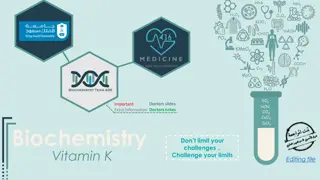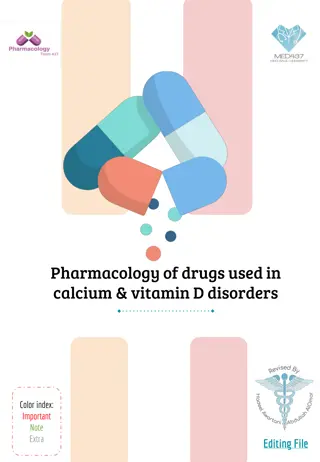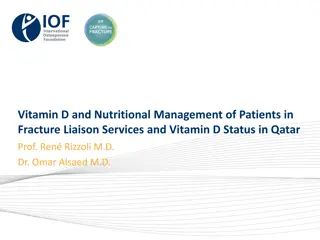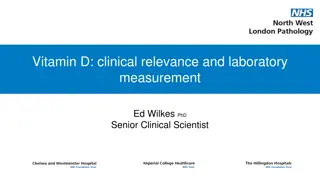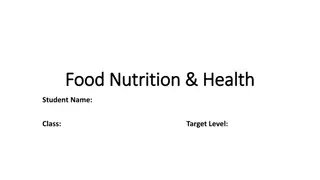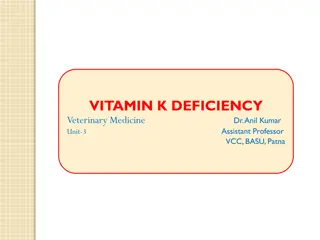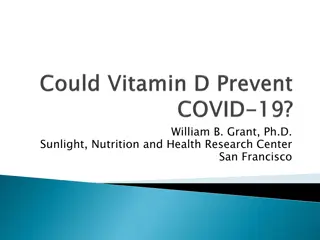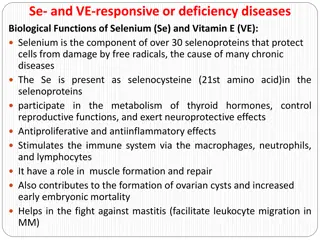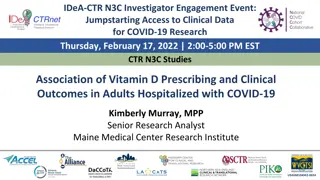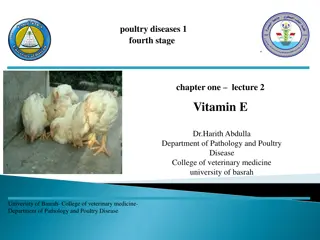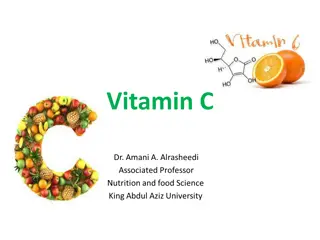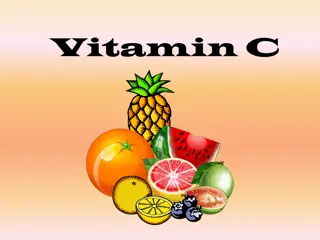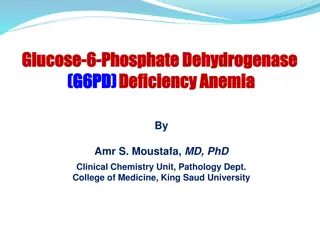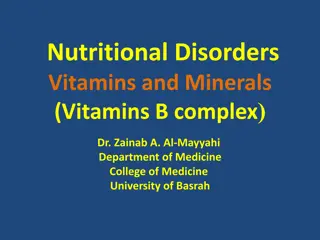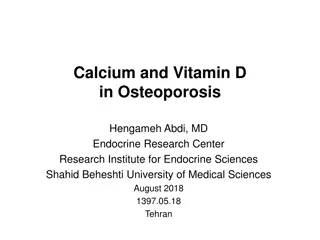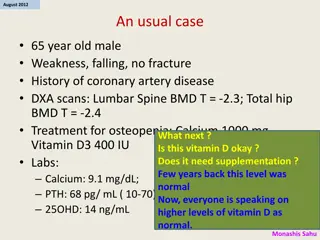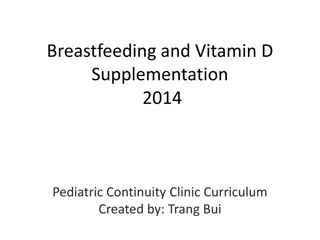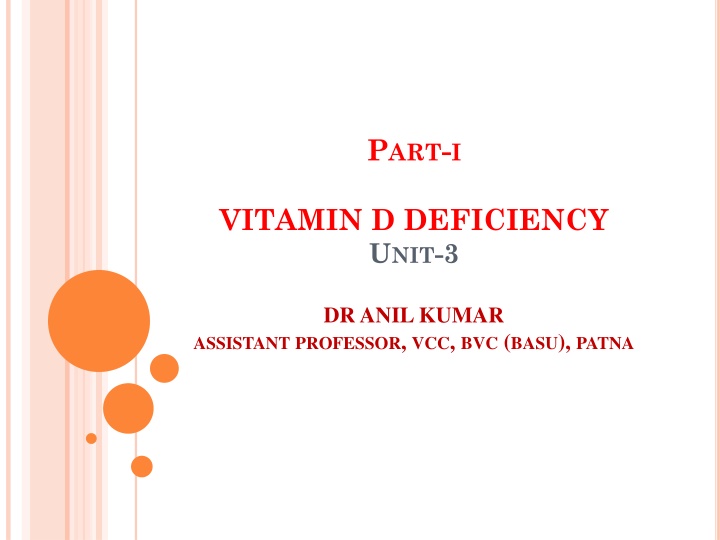
Vitamin D Deficiency: Causes, Symptoms, and Prevention
Vitamin D deficiency, often referred to as the sunshine vitamin deficiency, is caused by inadequate exposure to sunlight or insufficient intake of vitamin D through diet. It can lead to various health issues such as poor growth, osteodystrophy, and osteomalacia. This deficiency affects not only animals but also humans, impacting the immune system, cancer risks, and cardiovascular health. Factors like UV irradiation, dietary sources, and geographical location play crucial roles in determining the prevalence of vitamin D deficiency. Proper understanding and management of this issue are essential to maintain optimal health.
Download Presentation

Please find below an Image/Link to download the presentation.
The content on the website is provided AS IS for your information and personal use only. It may not be sold, licensed, or shared on other websites without obtaining consent from the author. If you encounter any issues during the download, it is possible that the publisher has removed the file from their server.
You are allowed to download the files provided on this website for personal or commercial use, subject to the condition that they are used lawfully. All files are the property of their respective owners.
The content on the website is provided AS IS for your information and personal use only. It may not be sold, licensed, or shared on other websites without obtaining consent from the author.
E N D
Presentation Transcript
PART-I VITAMIN D DEFICIENCY UNIT-3 DR ANIL KUMAR ASSISTANT PROFESSOR, VCC, BVC (BASU), PATNA
VITAMIN D DEFICIENCY Vitamin D is thought of as the sunshine vitamin . The two major natural sources of vitamin D are cholecalciferol (vitamin D3, which occurs in animals) and ergocalciferol (vitamin predominantly in plants) Etiology: Vitamin D deficiency is usually caused by: insufficient solar irradiation of animals or their feed, or inadequate concentrations of vitamin D in rations of housed animals It is manifested by poor appetite and growth and in advanced cases by osteodystrophy osteomalacia) It has a role in the immune system (Cattle), cancer, and cardiovascular disease in Human D2, which occurs (rickets or
Epidemiology: Occurs in animals in countries with relative lack of UV irradiation (winter months) Animals raised indoors for long periods. Young grazing animals in winter months Vitamin D is available to animals from either or both of: Isomerization of 7- dehydrocholesterol (7-DHC) in the skin to vitamin D3 during exposure to ultraviolet light or Ingestion of vitamin D2 or D3 in the diet (Few foods, including cod liver oil and fatty fish such as salmon and sardines, naturally contain high concentrations of vitamin D3) Ultraviolet Irradiation: The intensity of ultraviolet light that reaches the skin of the animal depends on latitude and altitude
It is less at higher latitudes, particularly during winter, when daylight hours are low When the altitude of the sun is >35 degree or higher, there is insufficient penetration of ultraviolet light to convert 7-DHC to previtamin D3 At high altitude, ultraviolet radiation may be intense, and animals may be exposed to excessive or prolonged exposure to sun. In these situations, previtamin D3 photoisomerizes to the biologically inert tachysterol and lumisterol, which are sloughed off with keratinocytes during normal skin turnover Poor irradiation are felt in : animals with dark skin (particularly pigs and some breeds of cattle) or heavy coats (particularly sheep) by rapidly growing animals and indoors for long periods. i. ii.
Longer time in sunlight is required for maximum previtamin D3 formation in dark-skinned animals Dietary Vitamin D: Irradiated plant sterols with antirachitic potency occur in the dead leaves of growing plants. Variation in the vitamin D content of hay can occur with different methods of curing. Exposure to irradiation by sunlight for long periods causes a marked increase in antirachitic potency of the cut fodder, whereas modern hay-making technique with its emphasis on rapid curing tends to keep vitamin D levels at a minimum The grazing of animals ( in winter) and on lush green feed including cereal crops, leads to a high incidence of rickets in the young one due to antivitamin D factor (Carotene)
Animal Risk Factors: Most herbivores efficiently produce vitamin D3 in the skin Inherited rickets in Corriedale sheep is caused by excessive vitamin D catabolism as a result of over expression of the gene for 25-hydroxyvitamin D3-24- hydroxylase, the enzyme responsible for catabolism of vitamin D. Foals have lower serum vitamin D concentrations than do adult horses PATHOGENESIS: skin or ingested absorbed by the small intestine LIVER 25-hydroxycholecalciferol is produced
LIVER 25-hydroxycholecalciferol is produced KIDNEY 1- -hydroxylase. 1,25- dihydroxycholec alciferol (DHCC) 24,25-DHCC 1. This vit. D is most active in eliciting intestinal calcium transport and absorption 2. Regulating the absorption and metabolism of the phosphate ion and especially its loss from the kidney. 3. A deficiency of the metabolite may occur in animals with renal disease, resulting in decreased absorption of calcium and phosphorus, decreased mineralization of bone, and excessive losses of the minerals through the kidney 4. The use of synthetic analogs of the active metabolites such as 1- - hydroxycholecalciferol (an analog of 1,25-DHCC) for the control of parturient paresis in cattle.
Maternal vitamin D status influencing the neonatal plasma calcium concentration Parenteral cholecalciferol treatment of sows before parturition is an effective method of supplementing neonatal piglets with cholecalciferol via the sow s milk and its metabolite via placenta transport CLINICAL FINDINGS: o Reduced productivity and Reproductive efficiency In the late stages, lameness, moslty in the forelegs, is accompanied in young animals by bending of the long bones and enlargement of the joints (clinical rickets osteomalacia) An adequate intake of vitamin D is necessary for the maintenance of fertility in cattle, particularly if the phosphorus intake is low
TREATMENT and CONTROL: A total daily intake of 7 to 12 IU/kg BW is optimal. Sun-dried hay is a good source, but green fodders are generally deficient in vitamin D Fish liver oils Irradiated dry yeast is probably a simpler and cheaper method of supplying vitamin D in mixed grain feeds The use of single IM injections of vitamin D2 (calciferol) in oil will protectruminants for 3 to 6 months The dose of 11,000 units/kg BW is recommended and should maintain an adequate vitamin D status for 3 to 6 months. Mature nonpregnant sheep(50Kg)-6000 IU/kg body, IM, adequate levels for 3 months. Pregnant ewes(2wks before lambing) @30,000, IM is adequate for Dam and lambs.
Excessive doses may cause toxicity, with signs of drowsiness, muscle weakness, fragility of bones, and calcification in the walls of blood vessels Important: o There is species variation to form vitamin D3 in their skin Exposure of dogs and cats to ultraviolet light does not significantly increase dermal vitamin D3 concentration DUE to the presence of 7-DHC-D7-reductase, an enzyme capable of degrading 7-DHC The main target organs for vitamin D are the intestine, bone, kidney, and parathyroid glands Rickets is rare in horses and appears to occur less frequently than in other domestic species



